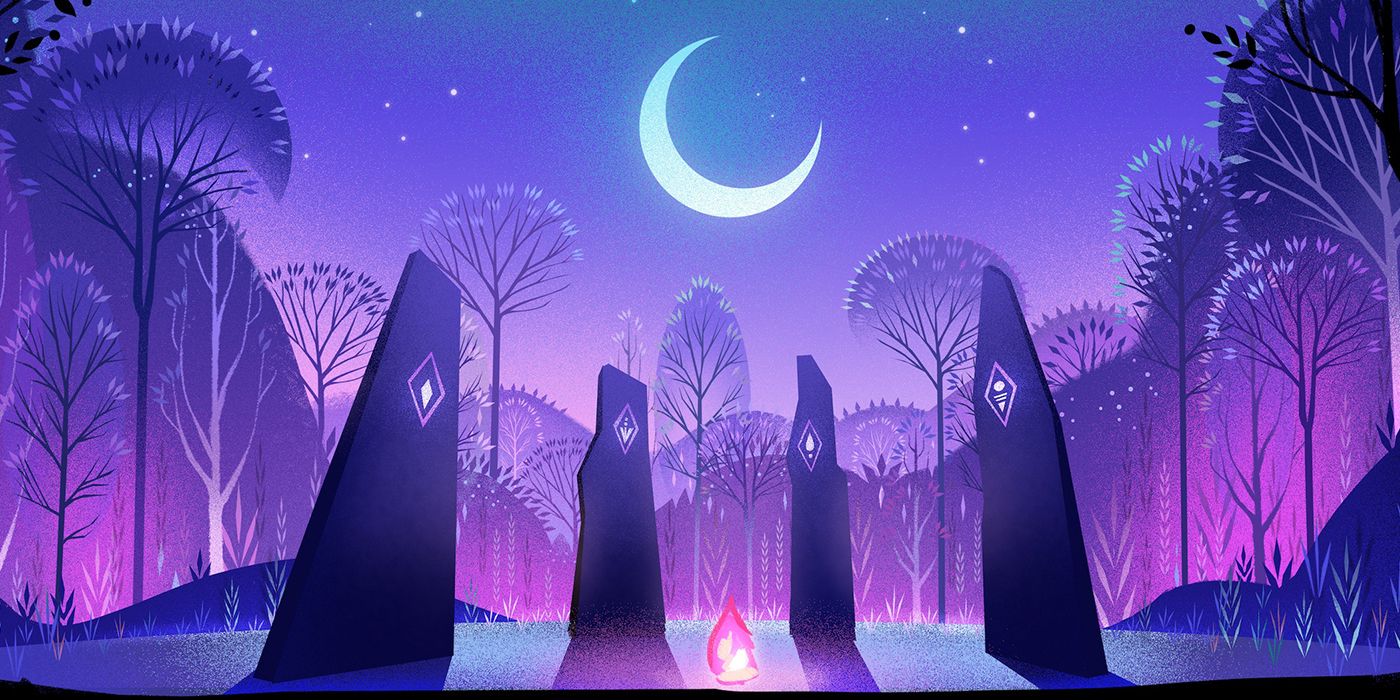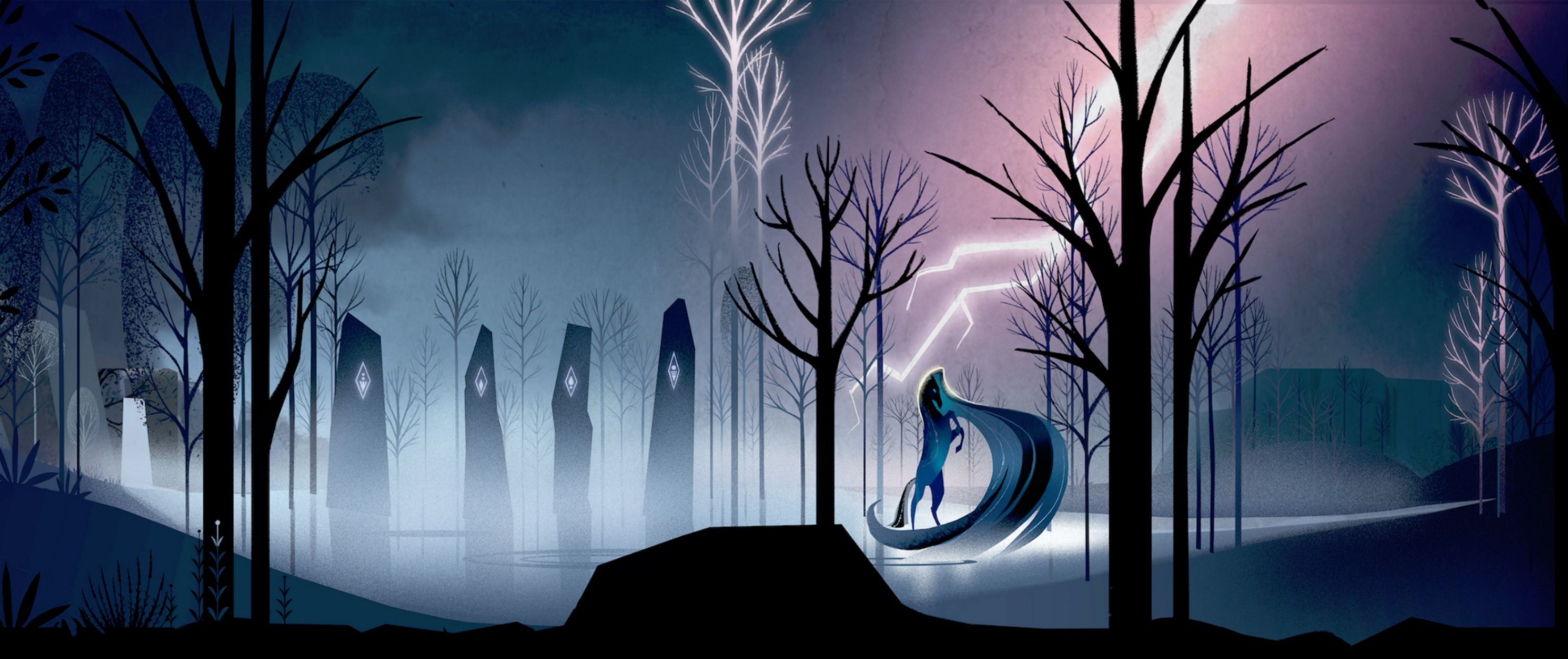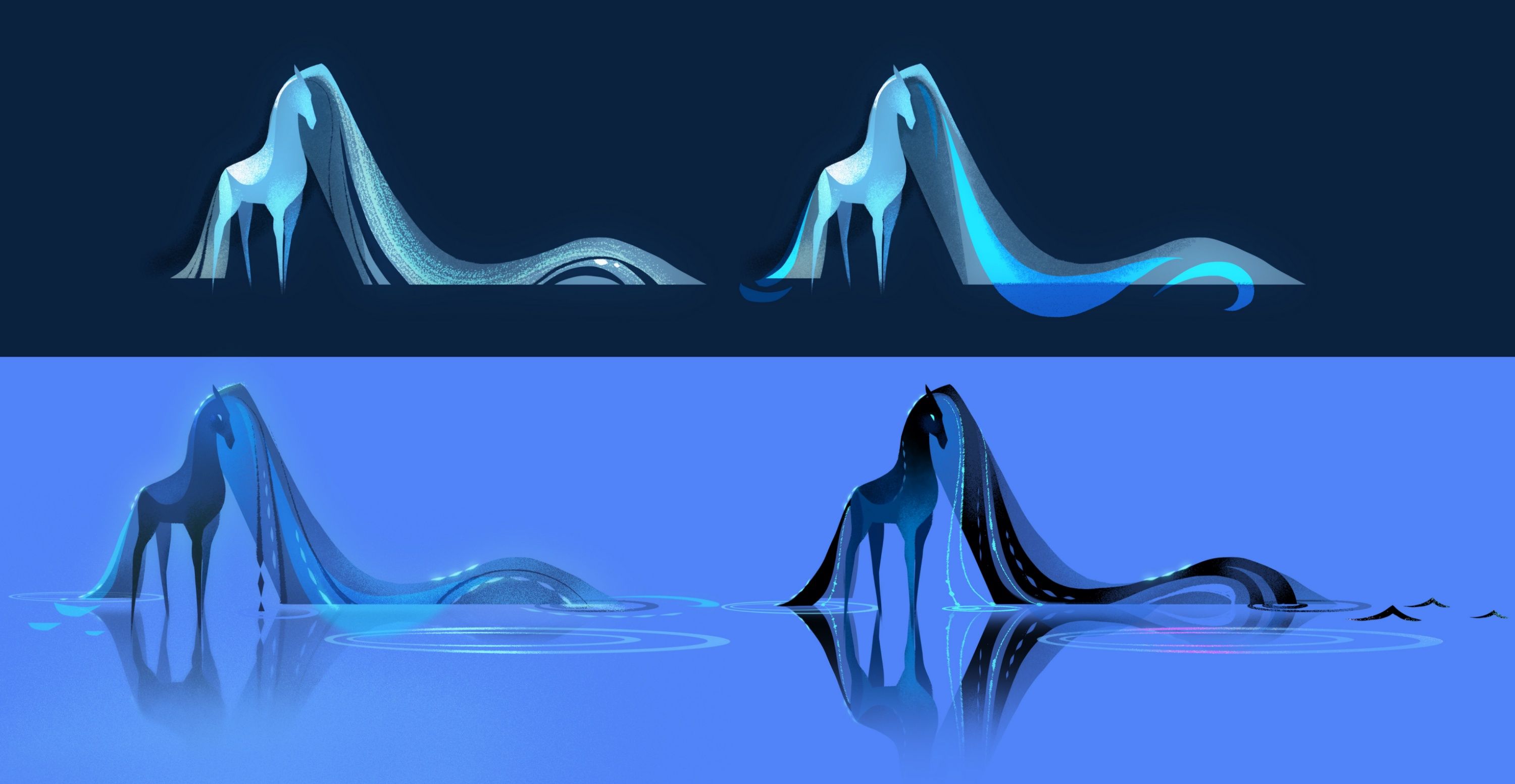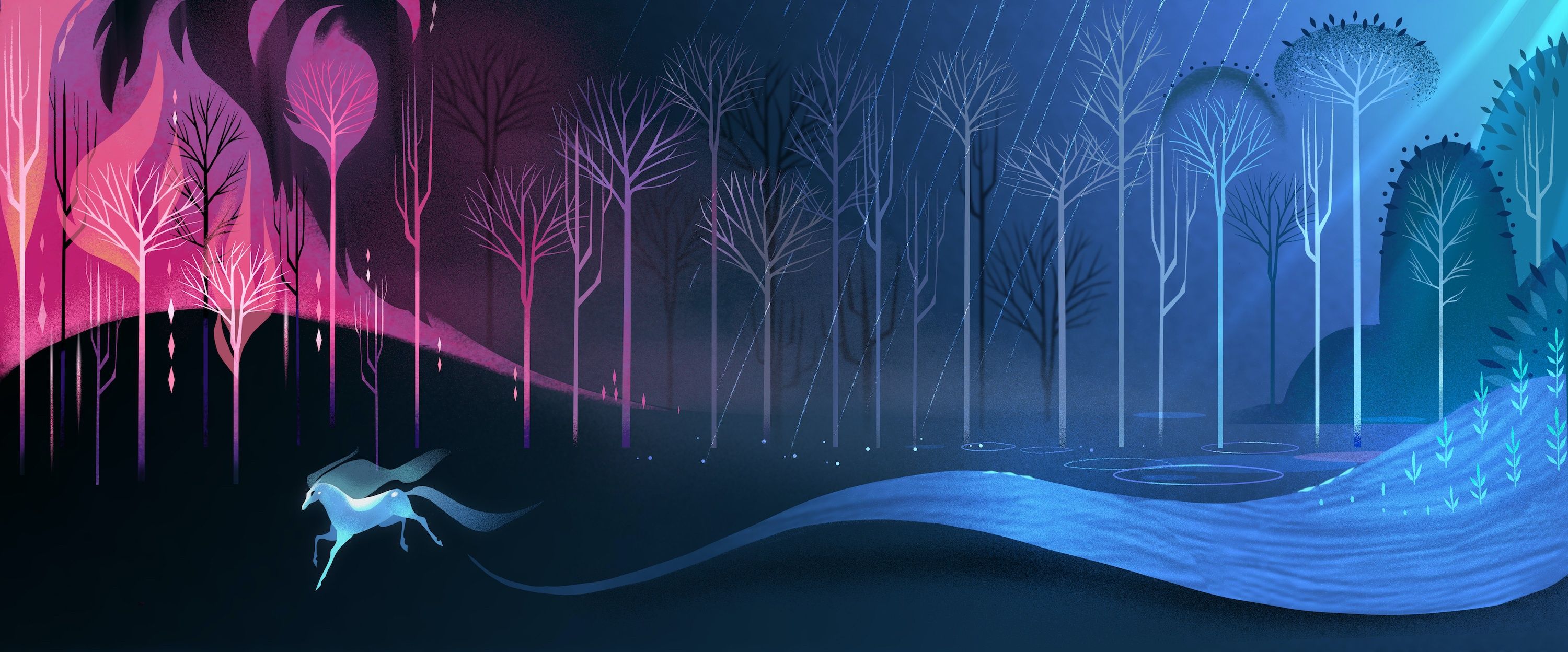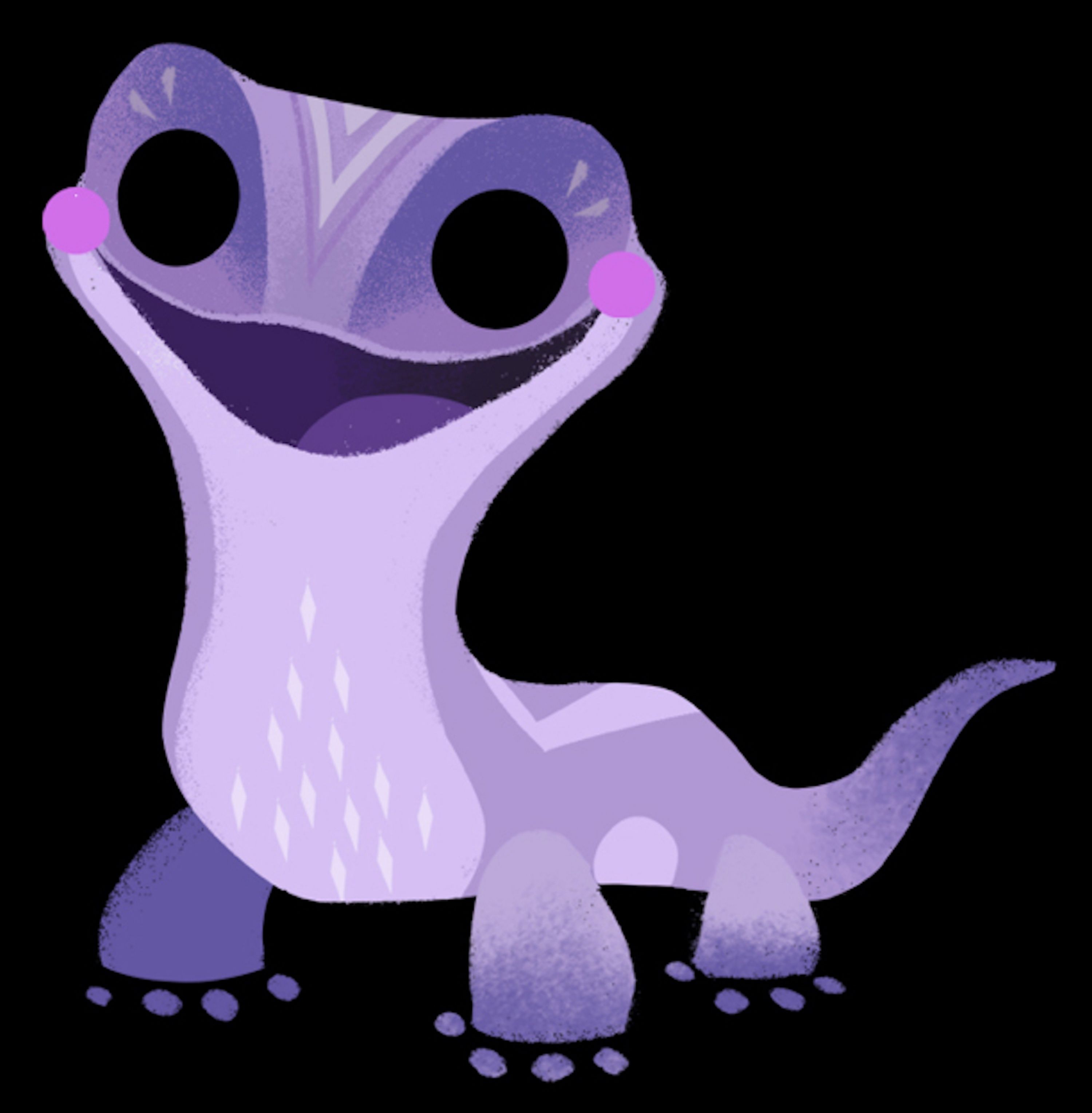From Walt Disney Animation Studios, the world of Frozen is being explored in a whole new way with the short film Myth: A Frozen Tale, which has taken inspiration from the environments, themes and elemental characters from Frozen 2, in developing and creating a tale set in an enchanted forest outside of Arendelle. As the tradition of telling bedtime stories manifests with narration from Queen Iduna (voiced by Evan Rachel Wood), the beautifully rich and vibrant world is brought to life through encounters with the water spirit known as the Nokk, the wind spirit Gale, the Earth Giants, and the fire spirit salamander named Bruni.
During a virtual press conference to discuss this interesting new look at the Frozen universe (which streams on Disney+ starting February 26th), director Jeff Gipson (Cycles) and production designer Brittney Lee talked about evolving this short from VR to 2D streaming, the most difficult spirit element to create, developing the shape language, enlisting composer Joe Trapanese (Tron: Legacy), the influence of Fantasia and the work of Mary Blair, and working with a world so rich that it continues to lend itself to different stories.
Question: Since this started for VR, did you go back to the original flat storyboards to inform what the camera sees, to create the 2D streaming version of Myth: A Frozen Tale?
JEFF GIPSON: Yeah, for some of it, we looked at the storyboards we initially pitched. Some of the action and some of the things have changed since then. We watched the VR version multiple times and were thinking, “Wow, how can we capture this feeling and this presence, but bring it to the screen, so people can watch it on streaming?” So, the storyboards informed a little bit, but it was more about, how can we capture that feeling of the VR version, and bring that into the streaming version?
Which was the most difficult spirit element to create?
GIPSON: I think the Nokk was a challenge. The Nokk in Frozen 2, is made out of water, and you have this beautiful mane and tail that moves. Of course, when I first started the film, I was like, “We should do something amazing like that.” But then, it was also about, “How do we stylize this, so that it fits into our film in this storybook world, but also integrates the diamond shape language and this paper cut-out cloth?”
BRITTNEY LEE: I agree. They all had their own unique challenges and we were tackling them at the same time. Because the Nokk was the one that you get the most up close and personal with, and it’s the closest to the viewer and closest to the camera, that was the one we spent the most time with and wanted to give the most love to. So, there was a lot of back and forth on the Nokk.
How did you approach the behavior of the water, in each sequence?
GIPSON: I think we really leaned on trying to think about the practical way these would be made. Thinking about the stylization of Brittney’s paper cut-out work that we were really referencing and leaning into, we also we looked at the dark attractions at Disneyland, like “It’s a Small World,” and how they achieve water effects. We used that as a reference.
LEE: I agree. There was a lot of experimentation going on throughout, but we were always wanting to have water. Water was the element that was the biggest piece that was a problem to solve and a challenge. We wanted it to still feel like it was stylized and a part of the storybook world. There are a lot of different ways in a pop-up book that you might see water stylized, based on the different uses of it, like a waterfall, a river, or a splash. We were looking to references, on all of those fronts, to caricature it and draw from some of the linear aspects of that. And then, we were using the linear pieces to infuse that into the 2D animation.
Is the salamander in the short the same character from Frozen 2, or is it just a relative or member of that same species?
LEE: We never really talked about it. I always just assumed it was Bruni.
GIPSON: I’d say it was Bruni, or a stylized idea of Bruni. I don’t really know. I’ll let fans speculate.
LEE: It’s the storybook version of Bruni.
Is there a deeper symbolism or significance to the diamond shape language?
LEE: The diamond shape language actually originated in Frozen 2. That’s how Elsa’s shape language evolved. Elsa is a bit of representation of the fifth spirit in Frozen 2, so we wanted to have a nod, but not too overtly be alluding, at all, to her particular character in this film. Because there is some of that shape language in Frozen 2 throughout, it felt like a good symbol to make consistent for each of the spirits. And we’re always looking for shape language that makes sense and that has some element of story to infuse in everything we do, so it just seemed like a total no-brainer to use it. I think the salamander in Frozen 2 actually also has some of the diamond shape language in its design, so that was part of the decision there, as well.
GIPSON: We really leaned into the diamond. It’s in the water splashes, it’s in the fire embers, it’s in the cliffs, it’s in everything. We really integrated it and tried to push it into all of the places.
How did you make the music choices for each scene?
GIPSON: We brought [Joe] Trapanese on early. I gave him this pitch about how it was about duality. Each element had this protagonistic and more antagonistic trait, and we talked about how to create the balance of that. We looked at references like Fantasia and all those other films, but I also loved a lot of the work he had done on Tron and with artists like M83. He would just create little 15-20 seconds snippets, and we would talk about them. It was really collaborative. He was on the earliest I’ve ever worked with a composer on a film and we went through what the feeling was. When you think about wind, you use air instruments. When you think about earth, there are these drums. I remember Joe showing us video of one of the percussionists actually using rocks and earth to make the drum beats for the section of the Earth Giants score. There are cool little fun things like that. In the fire salamander portion, there are flames and fire sounds that he was using. It was this really fun, unique process to go through.
LEE: It was neat, on the design side, because he was working so early that I could be working on design elements and listening to his earliest tracks. Even if they weren’t the final in the film, they were absolutely inspirational for what everything ended up looking like. It was great working with Joe.
Fantasia really combined the power of music with visuals in a striking way. Why is that film still so relevant, 80 years later?
LEE: I have always loved music and visuals working together in harmony, in any form, and Fantasia was maybe our first real pass at just that. It’s just so emotional and inspiring, and there’s a freedom to it too. You wholeheartedly submit to the music and see the visual representation of what music can be. For me, I find that incredibly inspiring and that’s something that, as new music and new visuals, and new ways of showing music and visuals come into play, it’s wonderful to explore. That’s something that is just universal. We all love listening to music and creating to much.
GIPSON: That’s exactly my thoughts, as well. It’s the that the visuals are tied to the music. One of my big inspirations or influences are music videos. I absolutely love music videos because there is this freedom to them, the way that you can create visuals that dance or play with that music. If you think about Fantasia, it’s almost one of the very first music videos. Some of the pieces in Fantasia are really abstract while others use characters, and I think there’s this fun, inspiring freedom to that. It connects with me still, to this day.
Was Mary Blair’s work one of your inspirations for the art design of Myth: A Frozen Tale?
LEE: Absolutely. Mary Blair is one of my personal heroes and a huge inspiration, more so in color. The shape language was definitely more based on Eyvind Earle, with the long, elegant and etherealness of that. But color wise, pushing into less realism and more fantasy, it was absolutely inspired by Mary Blair.
What led you to choose Evan Rachel Wood to narrate this?
GIPSON: I was just so excited. When she was announced to be a part of Frozen 2, and just thinking about her tonality as a storyteller, and some of the other projects that she’s been a part of and other characters that she’s played, are really inspiring. I just imagined her as this mother in the film, telling this bedtime story. Her tone was just amazing. It felt like a no-brainer.
The VR version allows audiences to decide which way to look and how to interact with the short. How did you decide which camera movements were better to tell the 2D story?
GIPSON: One of the challenges in VR is always, how do we draw the audience’s attention and make them look where we want them to look? When we talked about the proscenium arch, we designed that set to really frame each on of those story moments for the VR version. It actually translated over quite easily. We were really thoughtful about how were placing the characters and framing them in VR. Even with the storyboards early on, we thought about composition and had this in the back of our minds, all the way along. In the VR version, we have what we call the Gomez Effect, where if you’re not looking in the right spot, the music tones down, the color starts to desaturate, and the world starts to get dark.
Why is it called the Gomez Effect?
GIPSON: Our amazing lead of technology, José Gomez, who worked on Cycles as well as Myth, developed this technique to use on Cycles, and it just felt like we wanted to use this on Myth: A Frozen Tale. It really informed and helped create the streaming version for Disney+.
What was the biggest challenge in translating something that was originally meant for VR and turning it into this version for Disney+?
GIPSON: A big part of the VR version is that sense of presence you get with all of these characters. I love when the wind is swooping around you and you’re hearing it in the headphones, moving from left to right. How do we translate that sense of presence and scale and power that each one of these elemental spirits had? How do we make this feel like our VR version? I’m just so proud and really excited about what we achieved for our streaming version of the film.
What was some of the overall challenges you faced, while making Myth: A Frozen Tale?
LEE: For me, coming into working in the VR space, I had never had any experience with that before, so there were definitely things I needed to learn, coming out of working on films. There’s a shorthand that you learn working on films, and I had to erase all of that. There’s no depth of field in VR, so we had to really plan to figure out how we wanted the audience to look. Hopefully, in the streaming version that ends up working in our favor.
GIPSON: It was a cool process where Brittney and I were basically in two VR headsets and we were standing in the Enchanted Forest set dressing in real time. It was almost like we were on a live-action set, and Brittney and I were pointing and going, “A tree over here, and a tree over there.”
LEE: I’m sure that we looked ridiculous. I’m sure that there’s some behind-the-scenes footage somewhere, where we’re just sitting in a white room, pointing around at nothing.
GIPSON: Another challenge was that a lot of the crew had never worked in a real-time engine before. That speaks loudly about the amazing artists and technicians and people that we work with at the studio, that jump in to a new software package, learn it within two or three weeks, and then can execute production that’s Disney Animation-quality work, in such a short time frame. It’s incredible. It’s a nod to the amazing people that we work with.
There have been two movies and a few shorts now, but it feels like you’ve barely scratched the surface. What do you think it is about the Frozen universe that lends itself to creating so many different stories?
GIPSON: It’s just such a rich story and the characters are so intriguing. It’s such a rich world that it lends itself to that.
Myth: A Frozen Tale is available to stream at Disney+ on February 26th.

